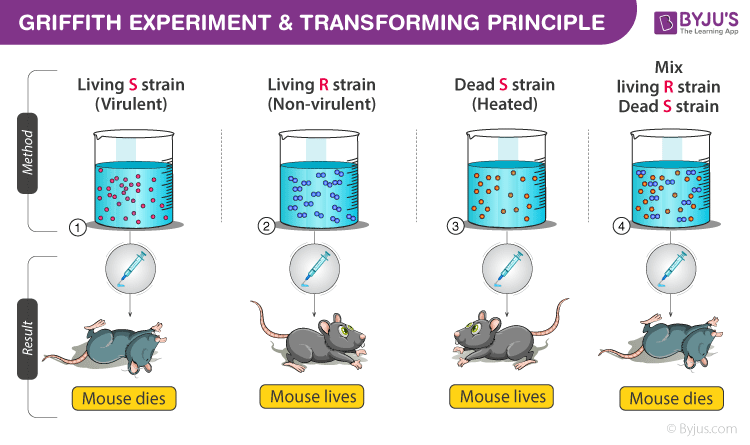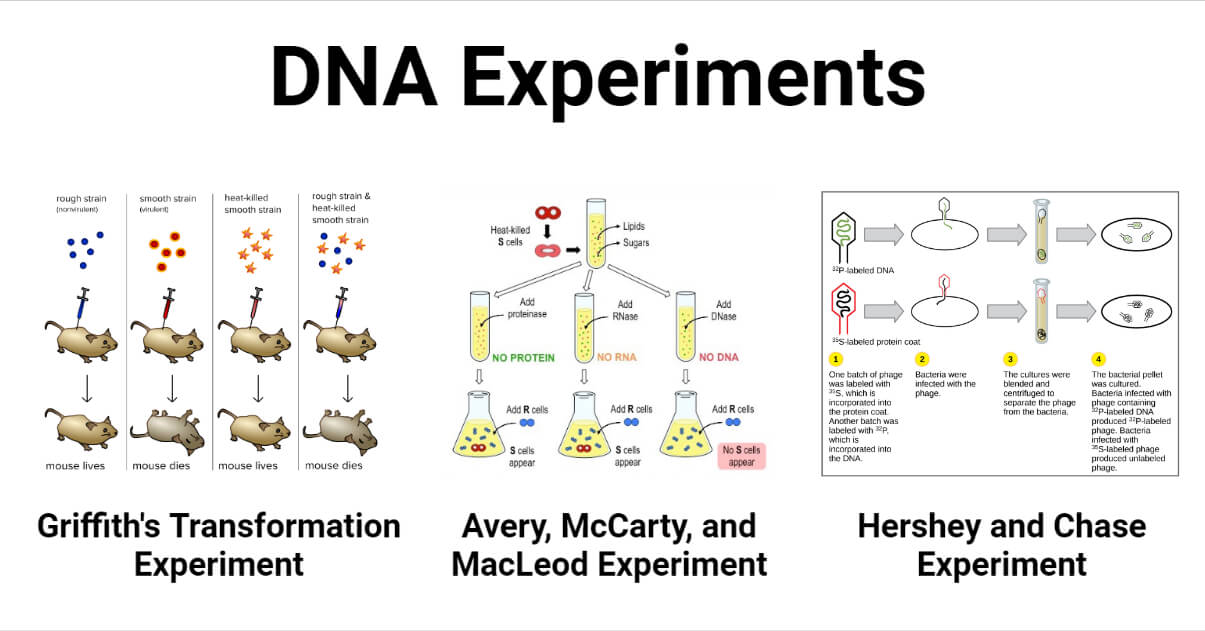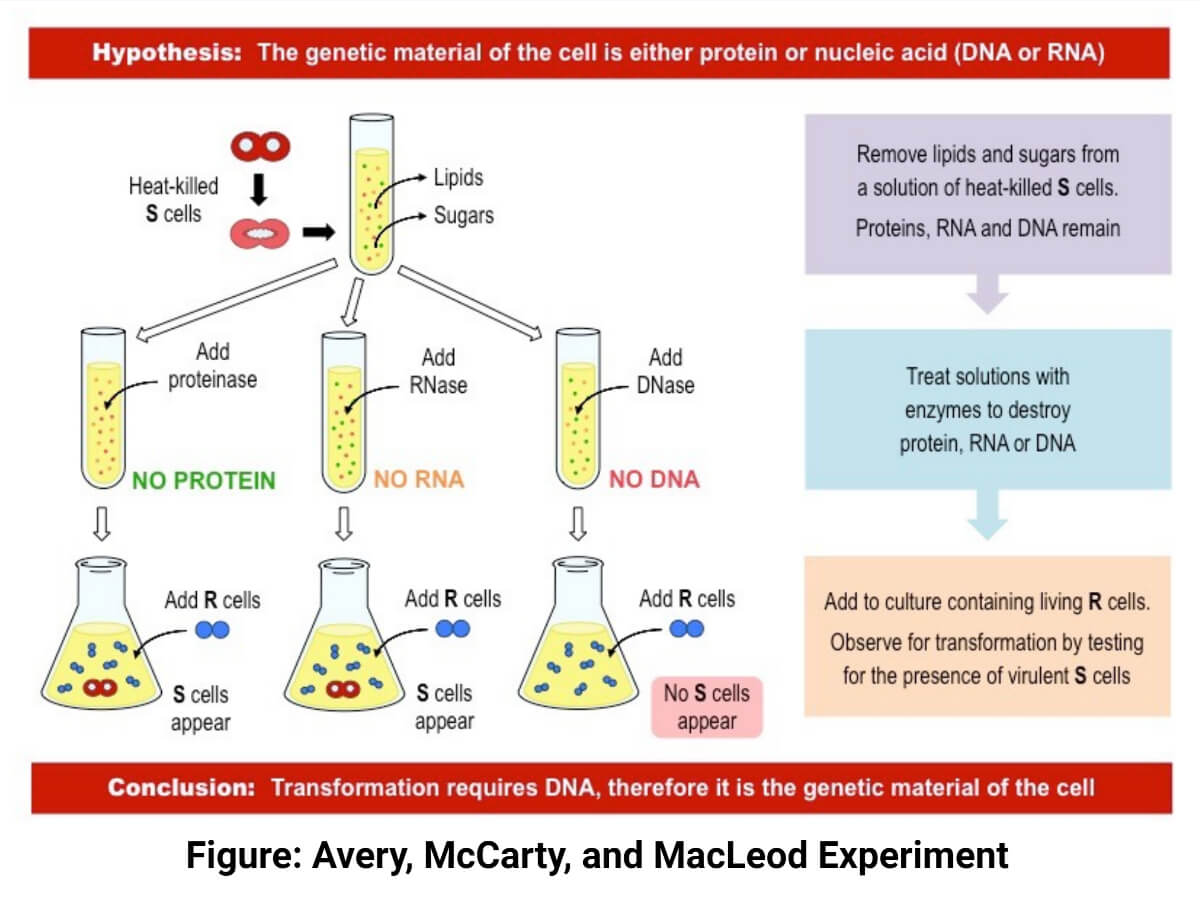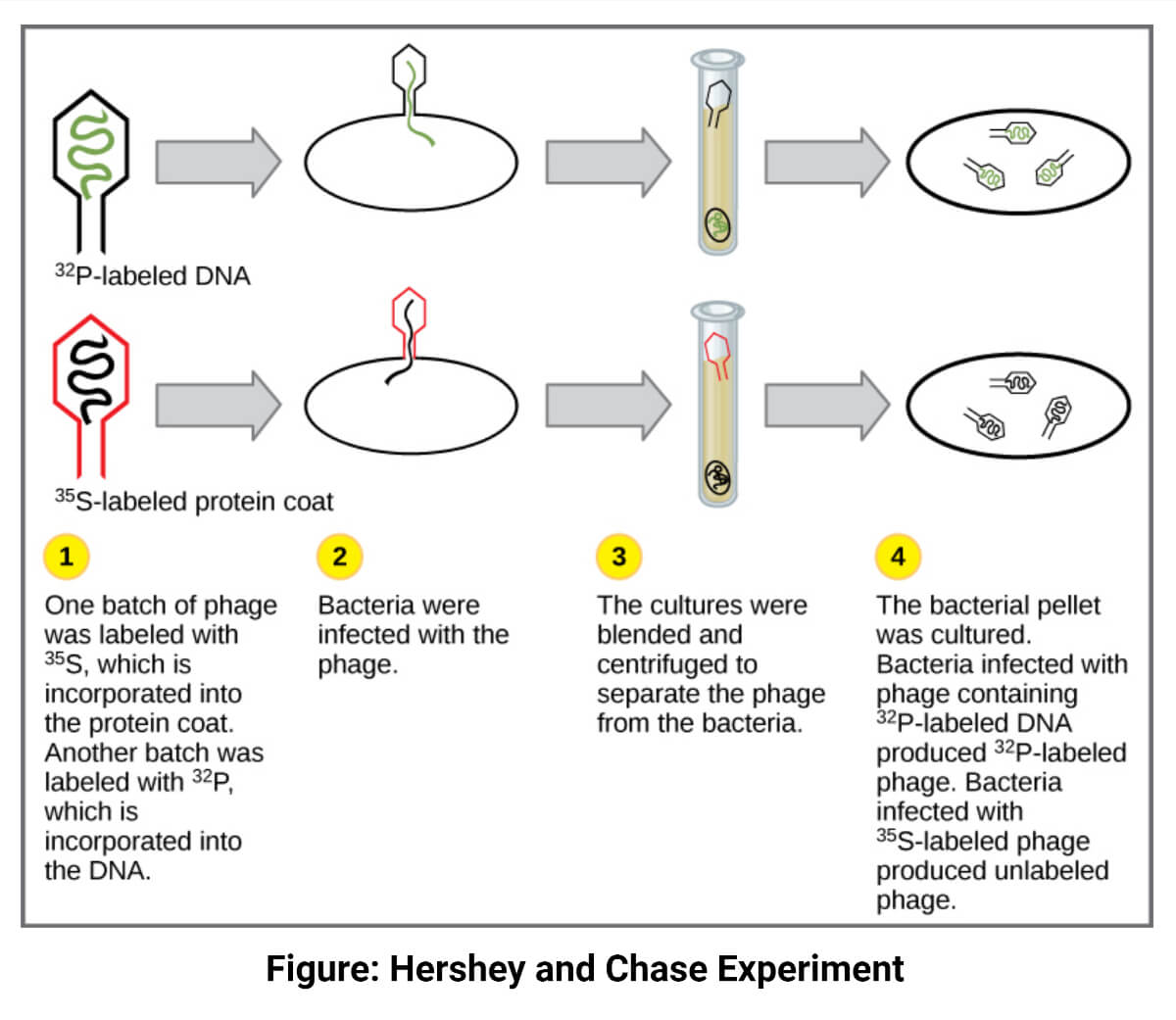- Biology Article
- Griffith Experiment Genetic Material

Griffith Experiment and Search of Genetic Material

The search for Genetic material started during the mid-nineteenth century. The principle of inheritance was discovered by Mendel. Based on his investigation, Mendel concluded that some ‘factors’ are transferred from one generation to another. Mendel’s Law of Inheritance was the basis for the researchers on genetic material. Keeping his conclusions in mind, scientists who came after him, focused on chromosomes in search of genetic material. Even though the chromosomal components were identified, the material which is responsible for inheritance remained unanswered. It took a long time for the acceptance of DNA as the genetic transformation. Let’s go through a brief account of the discovery of genetic material and Griffith experiment.
Griffith Experiment & Transforming Principle
Griffith experiment was a stepping stone for the discovery of genetic material. Frederick Griffith experiments were conducted with Streptococcus pneumoniae.
During the experiment, Griffith cultured Streptococcus pneumoniae bacteria which showed two patterns of growth. One culture plate consisted of smooth shiny colonies (S) while other consisted of rough colonies (R). The difference was due to the presence of mucous coat in S strain bacteria, whereas the R strain bacteria lacked them.
Experiment: Griffith injected both S and R strains to mice. The one which was infected with the S strain developed pneumonia and died while that infected with the R strain stayed alive.
In the second stage, Griffith heat-killed the S strain bacteria and injected into mice, but the mice stayed alive. Then, he mixed the heat-killed S and live R strains. This mixture was injected into mice and they died. In addition, he found living S strain bacteria in dead mice.

Conclusion: Based on the observation, Griffith concluded that R strain bacteria had been transformed by S strain bacteria. The R strain inherited some ‘transforming principle’ from the heat-killed S strain bacteria which made them virulent. And he assumed this transforming principle as genetic material.
DNA as Genetic Material
Griffith experiment was a turning point towards the discovery of hereditary material. However, it failed to explain the biochemistry of genetic material. Hence, a group of scientists, Oswald Avery, Colin MacLeod and Maclyn McCarty continued the Griffith experiment in search of biochemical nature of the hereditary material. Their discovery revised the concept of protein as genetic material to DNA as genetic material .
Avery and his team extracted and purified proteins, DNA, RNA and other biomolecules from the heat-killed S strain bacteria. They discovered that DNA is the genetic material and it is alone responsible for the transformation of the R strain bacteria. They observed that protein-digesting enzymes (proteases) and RNA-digesting enzymes (RNases) didn’t inhibit transformation but DNase did. Although it was not accepted by all, they concluded DNA as genetic material.
Frequently Asked Questions on Griffith Experiment
What was griffith’s experiment and why was it important.
Griffith’s experiment was the first experiment which suggested that bacteria can transfer genetic information through a process called transformation.
What is the conclusion of Griffith experiment?
The experiment concluded that bacteria are capable of transfering genetic information through transformation.
What was the most significant conclusion of Griffith’s experiments with pneumonia in mice?
The experiment conducted by Griffith found that bacteria are capable of transfering genetic information through transformation.
What did Frederick Griffith want to learn about bacteria?
Frederick Griffith wanted to learn if bacterial transformation was possible.
How did the two types of bacteria used by Griffith differ?
Griffith used two strains of pneumococcus (Streptococcus pneumoniae) bacteria: a type III-S and a type II-R.

Put your understanding of this concept to test by answering a few MCQs. Click ‘Start Quiz’ to begin!
Select the correct answer and click on the “Finish” button Check your score and answers at the end of the quiz
Visit BYJU’S for all Biology related queries and study materials
Your result is as below
Request OTP on Voice Call
Leave a Comment Cancel reply
Your Mobile number and Email id will not be published. Required fields are marked *
Post My Comment
Hi! This is well explained. I love it
Register with BYJU'S & Download Free PDFs
Register with byju's & watch live videos.

Microbe Notes
DNA Experiments (Griffith & Avery, McCarty, MacLeod & Hershey, Chase)
DNA, deoxyribonucleic acid, is the carrier of all genetic information. It codes genetic information passed on from one generation to another and determines individual attributes like eye color, facial features, etc. Although DNA was first isolated in 1869 by a Swiss scientist, Friedrich Miescher, from nuclei of pus-rich white blood cells (which he called nuclein ), its role in the inheritance of traits wasn’t realized until 1943. Miescher thought that the nuclein, which was slightly acidic and contained a high percentage of phosphorus, lacked the variability to account for its hereditary significance for diversity among organisms. Most of the scientists of his period were convinced by the idea that proteins could be promising candidates for heredity as they were abundant, diverse, and complex molecules, while DNA was supposed to be a boring, repetitive polymer. This notion was put forward as the scientists were aware that genetic information was contained within organic molecules.

Table of Contents
Interesting Science Videos
Griffith’s Transformation Experiment
In 1928, a young scientist Frederick Griffith discovered the transforming principle. In 1918, millions of people were killed by the terrible Spanish influenza epidemic, and pneumococcal infections were a common cause of death among influenza-infected patients. This triggered him to study the bacteria Streptococcus pneumoniae and work on designing a vaccine against it . It became evident that bacterial pneumonia was caused by multiple strains of S. pneumoniae, and patients developed antibodies against the particular strain with which they were infected. Hence, serum samples and bacterial isolates used in experiments helped to identify DNA as the hereditary material.
He used two related strains of S. pneumoniae and mice and conducted a series of experiments using them.
- When type II R-strain bacteria were grown on a culture plate, they produced rough colonies. They were non-virulent as they lacked an outer polysaccharide coat. Thus, when RII strain bacteria were injected into a mouse, they did not cause any disease and survived.
- When type I S-strain bacteria were grown on a culture plate, they produced smooth, glistening, and white colonies. The smooth appearance was apparent due to a polysaccharide coat around them that provided resistance to the host’s immune system. It was virulent and thus, when injected into a mouse, resulted in pneumonia and death.
- In 1929, Griffith experimented by injecting mice with heat-killed SI strain (i.e., SI strain bacteria exposed to high temperature ensuing their death). But, this failed to harm the mice, and they survived.
- Surprisingly, when he mixed heat-treated SI cells with live RII cells and injected the mixture into the mice, the mice died because of pneumonia. Additionally, when he collected a blood sample from the dead mouse, he found that sample to contain live S-strain bacteria.

Conclusion of Griffith’s Transformation Experiment
Based on the above results, he inferred that something must have been transferred from the heat-treated S strain into non-virulent R strain bacteria that transformed them into smooth coated and virulent bacteria. Thus, the material was referred to as the transforming principle.
Following this, he continued with his research through the 1930s, although he couldn’t make much progress. In 1941, he was hit by a German bomb, and he died.
Avery, McCarty, and MacLeod Experiment
During World War II, in 1943, Oswald Avery, Maclyn McCarty, and Colin MacLeod working at Rockefeller University in New York, dedicated themselves to continuing the work of Griffith in order to determine the biochemical nature of Griffith’s transforming principle in an in vitro system. They used the phenotype of S. pneumoniae cells expressed on blood agar in order to figure out whether transformation had taken place or not, rather than working with mice. The transforming principle was partially purified from the cell extract (i.e., cell-free extract of heat-killed type III S cells) to determine which macromolecule of S cell transformed type II R-strain into the type III S-strain. They demonstrated DNA to be that particular transforming principle.
- Initially, type III S cells were heat-killed, and lipids and carbohydrates were removed from the solution.
- Secondly, they treated heat-killed S cells with digestive enzymes such as RNases and proteases to degrade RNA and proteins. Subsequently, they also treated it with DNases to digest DNA, each added separately in different tubes.
- Eventually, they introduced living type IIR cells mixed with heat-killed IIIS cells onto the culture medium containing antibodies for IIR cells. Antibodies for IIR cells were used to inactivate some IIR cells such that their number doesn’t exceed the count of IIIS cells. that help to provide the distinct phenotypic differences in culture media that contained transformed S strain bacteria.

Observation of Avery, McCarty, and MacLeod Experiment
The culture treated with DNase did not yield transformed type III S strain bacteria which indicated that DNA was the hereditary material responsible for transformation.
Conclusion of Avery, McCarty, and MacLeod Experiment
DNA was found to be the genetic material that was being transferred between cells, not proteins.
Hershey and Chase Experiment
Although Avery and his fellows found that DNA was the hereditary material, the scientists were reluctant to accept the finding. But, not that long afterward, eight years after in 1952, Alfred Hershey and Martha Chase concluded that DNA is the genetic material. Their experimental tool was bacteriophages-viruses that attack bacteria which specifically involved the infection of Escherichia coli with T2 bacteriophage.
T2 virus depends on the host body for its reproduction process. When they find bacteria as a host cell, they adhere to its surface and inject its genetic material into the bacteria. The injected hereditary material hijacks the host’s machinery such that a large number of viral particles are released from them. T2 phage consists of only proteins (on the outer protein coat) and DNA (core) that could be potential genetic material to instruct E. coli to develop its progeny. They experimented to determine whether protein or DNA from the virus entered into the bacteria.
- Bacteriophage was allowed to grow on two of the medium: one containing a radioactive isotope of phosphorus( 32 P) and the other containing a radioactive isotope of sulfur ( 35 S).
- Phages grown on radioactive phosphorus( 32 P) contained radioactive P labeled DNA (not radioactive protein) as DNA contains phosphorus but not sulfur.
- Similarly, the viruses grown in the medium containing radioactive sulfur ( 35 S) contained radioactive 35 S labeled protein (but not radioactive DNA) because sulfur is found in many proteins but is absent from DNA.
- E. coli were introduced to be infected by the radioactive phages.
- After the progression of infection, the blender was used to remove the remains of phage and phage parts from the outside of the bacteria, followed by centrifugation in order to separate the bacteria from the phage debris.
- Centrifugation results in the settling down of heavier particles like bacteria in the form of pellet while those light particles such as medium, phage, and phage parts, etc., float near the top of the tube, called supernatant.


Observation of Hershey and Chase Experiment
On measuring radioactivity in the pellet and supernatant in both media, 32 P was found in large amount in the pellet while 35 S in the supernatant that is pellet contained radioactively P labeled infected bacterial cells and supernatant was enriched with radioactively S labeled phage and phage parts.
Conclusion of Hershey and Chase Experiment
Hershey and Chase deduced that it was DNA, not protein which got injected into host cells, and thus, DNA is the hereditary material that is passed from virus to bacteria.
- Fry, M. (2016). Landmark Experiments in Molecular Biology. Academic Press.
- https://bio.libretexts.org/Bookshelves/Introductory_and_General_Biology/Book%3A_Introductory_Biology_(CK-12)/04%3A_Molecular_Biology/4.02%3A_DNA_the_Genetic_Material
- https://byjus.com/biology/dna-genetic-material/
- https://bio.libretexts.org/Bookshelves/Genetics/Book%3A_Online_Open_Genetics_(Nickle_and_Barrette-Ng)/01%3A_Overview_DNA_and_Genes/1.02%3A_DNA_is_the_Genetic_Material
- https://www.toppr.com/guides/biology/the-molecular-basis-of-inheritance/the-genetic-material/
- https://www.nature.com/scitable/topicpage/discovery-of-dna-as-the-hereditary-material-340/
- https://www.biologydiscussion.com/genetics/dna-as-a-genetic-material-biology/56216
- https://www.nature.com/scitable/topicpage/discovery-of-the-function-of-dna-resulted-6494318/
- https://www.ndsu.edu/pubweb/~mcclean/plsc411/DNA%20replication%20sequencing%20revision%202017.pdf
- https://www.britannica.com/biography/Frederick-Griffith
- https://ib.bioninja.com.au/higher-level/topic-7-nucleic-acids/71-dna-structure-and-replic/dna-experiments.html
- https://biolearnspot.blogspot.com/2017/11/experiments-of-avery-macleod-and.html
- https://www.khanacademy.org/science/biology/dna-as-the-genetic-material/dna-discovery-and-structure/a/classic-experiments-dna-as-the-genetic-material
About Author
Prakriti Karki
Leave a Comment Cancel reply
Save my name, email, and website in this browser for the next time I comment.
This site uses Akismet to reduce spam. Learn how your comment data is processed .

- _PDF Printed Notes
- _PPT Slides
- _PPT Slides in PDF format
- _Intext Questions & Answers
- _Exercise and Answers
- _MCQs and Answers
- _Online Test Series
- _Activity Solutions
- _PDF Printed notes
- _Capsule Notes
- _Class 10 PPT
- _Class 11 PPT
- _Class 12 PPT
- _Exam Capsule PPT
- Online Tests
- _Chemistry Notes
- _Animal Facts
- _Body Facts
- _Comparison between
- _What and Why
Molecular Basis of Inheritance - Notes | Class 12 | Part 2: The Search for Genetic Material
6. MOLECULAR BASIS OF INHERITANCE
THE SEARCH FOR GENETIC MATERIAL
Frederick Griffith used mice & Streptococcus pneumoniae .
Streptococcus pneumoniae has 2 strains :
◦ Smooth (S) strain (Virulent): Has polysaccharide mucus coat. Cause pneumonia.
◦ Rough (R) strain (Non-virulent): No mucus coat. Do not cause Pneumonia.
Experiment:
- S-strain → Inject into mice → Mice die
- R-strain → Inject into mice → Mice live
- S-strain (Heat killed) → Inject into mice → Mice live
- S-strain (Heat killed) + R-strain (live) → Inject into mice → Mice die
He concluded that some ‘transforming principle’ transferred from heat-killed S-strain to R-strain. It enabled R-strain to synthesize smooth polysaccharide coat and become virulent. This must be due to the transfer of genetic material.
2. Biochemical characterization of transforming principle
- Oswald Avery, Colin MacLeod & Maclyn McCarty worked to determine the biochemical nature of ‘transforming principle’ in Griffith’s experiment.
- They purified biochemicals (proteins, DNA, RNA etc.) from heat killed S cells using suitable enzymes.
- They discovered that
- Digestion of protein and RNA (using Proteases and RNases ) did not affect transformation. It means that the transforming substance was not a protein or RNA.
- Digestion of DNA with DNase inhibited transformation. It means that DNA caused transformation of R cells to S cells. It proves that DNA was the transforming principle.
3. Hershey-Chase Experiment (Blender Experiment)-1952
- Hershey & Chase grew some bacteriophage viruses on a medium containing radioactive phosphorus ( P 32 ) and some others on medium containing radioactive sulphur ( S 35 ) .
- Viruses grown in P 32 got radioactive DNA because only DNA contains phosphorus. Viruses grown in S 35 got radioactive protein because protein contains sulphur.
- These preparations were used separately to infect E. coli.
- After infection, the E. coli cells were gently agitated in a blender to remove the virus particles from the bacteria.
- Then the culture was centrifuged to separate lighter virus particles from heavier bacterial cells.
- Bacteria infected with viruses having radioactive DNA were radioactive. i.e., DNA had passed from the virus to bacteria. Bacteria infected with viruses having radioactive proteins were not radioactive. i.e., proteins did not enter the bacteria from the viruses. This proves that DNA is the genetic material .

- Topic 1: The DNA
- Topic 2: The Search for Genetic Material
- Topic 3: Properties of Genetic Material, RNA World
- Topic 4: DNA Replication
- Topic 5: Transcription
- Topic 6: Genetic Code, Types of RNA
- Topic 7: Translation (Protein Synthesis)
- Topic 8: Regulation of Gene Expression, Operon Concept
- Topic 9: Human Genome Project (HGP)
- Topic 10: DNA Fingerprinting

- Class 12 Syllabus
- Class 12 Revision Notes
- Maths Notes Class 12
- Physics Notes Class 12
- Chemistry Notes Class 12
- Biology Notes Class 12
- NCERT Solutions Class 12 Maths
- RD Sharma Solutions Class 12
Search For Genetic Material
The search for genetic material has been important in understanding inheritance and evolution. Scientists have explored various models and experiments to identify the substance responsible for transmitting hereditary traits. From Griffith’s transformation experiments to Avery, MacLeod, and McCarty’s confirmation of DNA’s role, these discoveries have shaped modern genetics. This article delves into key experiments and milestones in the quest to unravel genetic material’s identity and significance in biological processes.
Understanding genetic material is crucial in Class 12 to grasp genetics and its properties comprehensively.
Table of Content
The Search for Genetic Material
Transforming principle – griffith experiment, biochemical characterization of transforming principle, properties of genetic material, replication of dna, dna as genetic material, conclusion: search for genetic material.
Many scientists performed various experiments to have evidence that determines that DNA is the genetic material. Previous discoveries made by Gregor Mendel, Walter Sutton, Thomas Hunt Morgan, and other scientists had narrowed the search to the chromosomes which are located in the nucleus of most cells but still the question of what molecule was actually the genetic material arises. Therefore the following experiments below determine the DNA as genetic material.
A couple of experiments were performed with Streptococcus pneumoniae by Frederick Griffith in 1928 . When on a culture plate Streptococcus pneumoniae are grown some of them produce smooth shiny colonies (S) while others produce rough colonies (R). The mice die from pneumonia which is infected with the S strain (virulent) while the other does not develop pneumonia which is infected with the R strain.
- S Strain – Inject into mice – Mice die
- R Strain – Inject into mice – Mice live
Griffith was able to kill the bacteria by heating them. When the heat-killed S strain bacteria were injected into the mice, it doesn’t kill the mice while when the heat-killed S strain and live R strain bacteria the mice died. Therefore, he recovered the living S bacteria from the dead mice.

- S strain – Inject into mice – Mice live
- S strain + R strain – Inject into mice – Mice die
Lastly, Griffith concludes that R-strain bacteria were transformed by the heat-killed S-strain bacteria which happens due to the transfer of the genetic material But he cannot conclude about the biochemical nature of genetic material.
Oswald Avery, Colin Macleod, and Maclyn McCarty worked together to determine the biochemical nature of the transforming principle in Griffith’s experiment . They purified the biochemicals such as proteins, DNA, RNA , and so on from the heat-killed S cells to analyze which one could transform live R cells into S cells.
They discovered that DNA alone from the S bacteria causes R bacteria to become transformed. They also discovered that the transformation doesn’t affect the protein-digesting enzymes and RNA-digesting enzymes . Therefore it was concluded that transforming substances are not RNA or protein and DNA was the cause of transformation. Thus, DNA is the hereditary material.
- It should be stable both structurally and chemically.
- It should express itself in the form of Mendelian Characters.
- It should follow mutation for evolution.
- It should obey replication and therefore can able to replicate.
Replication of DNA is the process in which two strands separate and act like a template for the synthesis of new complementary strands. When replication is completed each DNA molecule consists of one parental and one new synthesis strand. The schema of replication was known as semiconservative DNA replication.
DNA (deoxyribonucleic acid) serves as the fundamental genetic material in all known living organisms. Its role was confirmed through landmark experiments such as the Avery-MacLeod-McCarty experiment in 1944, which demonstrated that DNA, and not protein , carries genetic information. Further studies, including the Hershey-Chase experiment in 1952, solidified DNA’s role by showing that viral DNA, not protein, directs viral replication.
These discoveries revolutionized biology, leading to the understanding that DNA encodes hereditary information through its sequence of nucleotides, which governs the development, function, and diversity of living organisms. DNA’s significance continues to underpin advancements in genetics, medicine, and biotechnology today.
To identify genetic material has been a journey marked by groundbreaking discoveries and experiments, culminating in the recognition of DNA as the molecule responsible for transmitting hereditary information. From the initial doubt to the conclusive experiments, scientific efforts have revolutionized our understanding of inheritance and paved the way for transformative advancements in genetics and biotechnology. DNA stands as the cornerstone of biological research and discovery.
FAQs on the Search for Genetic Material
What do you mean by the transforming principle.
It is a principle in which a couple of experiments were performed with Streptococcus pneumoniae by Frederick Griffith in 1928 to conclude the transfer of genetic material.
What has been Concluded from the Hershey and Chase Experiment?
It has been concluded that DNA was the material that passes from virus to the bacteria. The bacteria which were infected by the viruses had radioactive proteins and were not affected. Thus, it indicates that protein did not enter the bacteria from the viruses which proved that DNA passes from virus to bacteria and DNA is a genetic material.
What are the Two Properties of Genetic Material?
The two properties of Genetic material are as follows: It should follow mutation for evolution, and it can able to replicate.
What do you mean by Replication of DNA?
It is the process in which two strands separate and acts like a template for the synthesis of new complementary strands.
Who Discovered Genetic Material?
Alfred Hershey and Martha Chase conclusively demonstrated in 1952 that DNA serves as genetic material. Their groundbreaking experiments with bacteriophages provided compelling evidence supporting DNA’s role in heredity, establishing it as the primary molecule responsible for transmitting genetic information in living organisms.
What is Genetic Material Class 12?
Genetic material refers to molecules like DNA or RNA that carry genetic information and pass it from one generation to the next.

Similar Reads
- School Biology
- School Learning
Improve your Coding Skills with Practice
What kind of Experience do you want to share?
Talk to our experts
1800-120-456-456
What is Griffith transforming principle? Explain Griffith experiments on Streptococcus pneumoniae while searching for genetic material.
- Question Answer
- What is Griffith transforming ...

Repeaters Course for NEET 2022 - 23

IMAGES
VIDEO
COMMENTS
Griffith Experiment- This experiment was a stepping stone for the discovery of genetic material as Frederick Griffith carried out experiments with Streptococcus pneumoniae. Login. Study Materials. NCERT Solutions. NCERT Solutions For Class 12. ... Class 12 CBSE Notes; CBSE Revision Notes. CBSE Class 9 Revision Notes; CBSE Class 10 Revision ...
Learn about Griffith Experiment topic of Biology in details explained by subject experts on vedantu.com. Register free for online tutoring session to clear your doubts. ... Class 12 Biology Notes Class 11 Biology Notes Class 10 Science Notes Class 9 Science Notes Class 8 Science Notes Class 7 Science Notes Class 6 Science Notes.
Identify the conclusion drawn by Griffith from his experiments. Nucleic acids are the infective substances in viruses were discovered by: Replication was allowed to take place in the presence of radioactive deoxynucleotides precursors in E.coli that was a mutant for DNA ligase.
Griffith's Experiment in 1928 demonstrated bacterial transformation, where non-virulent bacteria turned virulent upon exposure to heat-killed virulent strains.Avery, MacLeod, and McCarty experiment later confirmed in 1944 that DNA, not proteins, was the genetic material responsible for this transformation. Griffith Experiment in conclusion recognized DNA's significant role in heredity.
Figure: Hershey and Chase Experiment. Image Source: OpenStax Biology. Observation of Hershey and Chase Experiment. On measuring radioactivity in the pellet and supernatant in both media, 32 P was found in large amount in the pellet while 35 S in the supernatant that is pellet contained radioactively P labeled infected bacterial cells and supernatant was enriched with radioactively S labeled ...
PDF Notes, PPTs, Online Tests and Question Banks for Class 10, Class 11, Class 12, NEET etc. PDF Notes, PPTs, Online Tests and Question Banks for Class 10, Class 11, Class 12, NEET etc. Home; Class 9; ... Colin MacLeod & Maclyn McCarty worked to determine the biochemical nature of 'transforming principle' in Griffith's experiment.- They ...
Physics Notes Class 12; ... Griffith's Experiment in 1928 demonstrated bacterial transformation, where non-virulent bacteria turned virulent upon exposure to heat-killed virulent strains. Avery, MacLeod, and McCarty experiment later confirmed in 1944 that DNA, not proteins, was the genetic material responsible for this transformation. ...
In 1928, Frederick Griffith, in a series of experiments with Streptococcus pneumoniae (bacterium responsible for pneumonia), witnessed a miraculous transformation in the bacteria. During the course of his experiment, a living organism (bacteria) had changed in physical form. When Streptococcus pneumoniae (pneumococcus) bacteria are grown
Ans: Hint: Griffith performed this experiment to find genetic material. During the experiment, the bacteria Str... Courses. Courses for Kids. Free study material. Offline Centres. More. Store. Talk to our experts. 1800-120-456-456 ... Revision Notes for Class 12. NCERT Books. Maths Formula for Class 12. Sample Papers. Class 12 Maths. Class 12 ...
Fig. 7.1: Griffith's transformation experiment. Rough strain Smooth strain Heat-killed Rough strain smooth strain. Mouse survives Mouse dies Mouse survives Mouse dies. Heat-killed smooth strain + Chapter 7.indd 165 20-Sep-21 11:57:36 AM. 2024-25. 166. B. IOTCHOLOGY. In order to understand further, Griffith killed some .